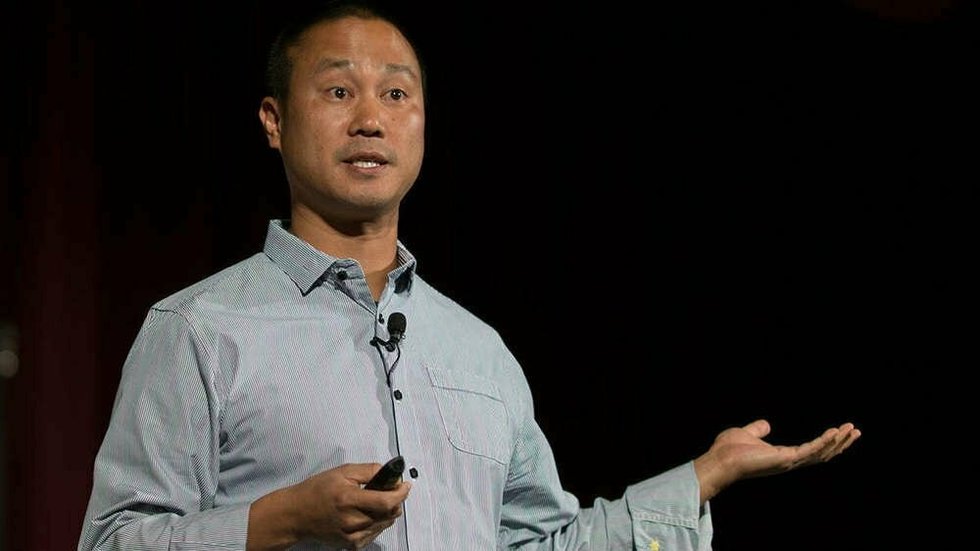Tribute to Tony Hsieh: five lessons in management
11 déc. 2020
4min


Autrice, consultante et conférencière sur le futur du travail, spécialiste de la productivité, de l’âge et du travail des femmes
The recent death of 46-year-old Tony Hsieh, the founder of Zappos and master of managerial innovation, has attracted a huge amount of attention among students of technology and management. The many tributes voiced in the weeks following his death are a testament to his legacy.
The son of Taiwanese migrants, Hsieh grew up in the San Francisco Bay Area, studied at Harvard, and subsequently enjoyed a stratospheric rise during the late 1990s internet boom. In 1999, he launched Zappos, a hugely successful online shoe retailer, which was bought by Amazon in 2009.
In 2010, he wrote his best-seller Delivering Happiness: A Path to Profits, Passion, and Purpose, in which he told the story of his life as an entrepreneur, his creation of Zappos’s workplace culture, and the innovative management ideas that had made his company a famous “holacracy” in the business world. Although he did not dream up the idea of a holacracy, Hsieh was the key figure when it came to establishing the concept and implementing it.
Holacracy is a model of working based on decentralized management and the distribution of decision-making throughout an organization composed of self-managed teams. According to this model, “holons” are autonomous, independent teams and groups linked to the “higher entity” of which they are a part. The system was first developed by tech entrepreneur and author Brian Robertson, but Hsieh played the primary role in popularizing it, despite having moved away from the concept in the last few years of his life. Indeed, for a long time Zappos was probably the only example of a holacratic organization.
As our tribute, here are five management lessons learned from Hsieh’s life, career, and writings.
1. It all starts with customer service
Zappos built its success on its renowned customer service. Zappos employees spent hours on the phone with customers—such calls had no time limits—and they weren’t always just talking about shoes. While shoes weren’t initially considered an easy product to sell online, Zappos changed that view thanks to the fluidity and overall excellence of its customer experience, making Zappos an essential point of reference for online retailers.
Adding this “wow factor” to customer service helped to shape Zappos’s unique corporate culture. What’s more, a key part of this culture involved helping Zappos employees in their professional and personal development. By the time Amazon acquired the business for $1.2 billion in 2009, Zappos was ranked by Fortune as one of the top 25 companies to work for.
Amazon chief executive Jeff Bezos praised Hsieh for the impact of his approach to customer service. “The world lost you way too soon… your curiosity, vision, and relentless focus on customers leave an indelible mark,” he wrote on Instagram.
2. With a sense of resourcefulness and unfailing kindness, you will go far
The people who knew Hsieh personally emphasized his humanity. Hsieh may have had an Ivy League education, but it was more his resourcefulness and determination that made the real difference. In fact, his Harvard classmates say he didn’t do much work in college. Former classmate and venture capitalist Alfred Lin said: “I was always impressed with his ability to do as little work as possible and still get the best grades. He did the least amount of preparation to get himself onto the computer ‘Olympics’ team. He was always thinking about leverage and why businesses fail.”
One of his essential qualities was “grit”: a mix of guts and perseverance. True perseverance and powerful motivation are the keys to professional success and Hsieh had vast resources of both.
3. Throw a bit of fun and weirdness into your management
During job interviews at Zappos, Hsieh used to ask candidates, “On a scale of one to 10, how weird are you?” According to Inc magazine, he explained later why he asked this: “If you’re a 1, you’re probably a little bit too strait-laced for us; if you’re a 10, you might be too psychotic for us. It’s not so much the number; it’s more seeing how candidates react to a question.”
In a company that seeks to innovate, it can take “weird” people to get ahead. Hsieh often favored unconventional approaches at Zappos. So, for example, whereas most businesses generally saw customer service as a cost that should be minimized, Hsieh wanted to spend more money on it—a lot more. It’s this “weirdness” that helped to make Zappos such an extraordinary success story.
If there were such a thing as a “weirdness scale”, Hsieh would certainly have had a high score. His creativity was unparalleled and sometimes uncontrollable. He would repeatedly throw his employees one eccentric idea after another. Then it was up to them to maximize the potential of those ideas.
4. Your creative potential depends on your purpose
A manager with their own raison d’être is a fashionable concept nowadays, but beyond the term itself, there is often nothing more than empty rhetoric. However, in a holacracy, where there is no manager in the usual sense and individuals manage themselves, the raison d’être becomes vital. This is absolutely central to the story of Zappos and Hsieh talks about its origins in Delivering Happiness.
For Robertson, the person behind the concept of holacracy, the raison d’être of a holacratic organization is “the deepest creative potential it can sustainably express in the world, given all of the constraints acting upon it and everything available to it. That includes its history, current capacities, available resources, partners, character, culture, business structure, brand, market awareness, and all other relevant resources or factors.”
This approach unites the actions of individuals who will contribute to its realization through their own skills, abilities, and involvement. To further this approach, the organization is structured in circles. Each circle has its own approach that contributes to the overall raison d’être, while remaining autonomous in its own functioning.
5. A model based on self-management is centered around two seemingly contradictory things: reliability and adaptability.
Reliability is associated with maximizing profits for shareholders, job stability, and quality customer service. Adaptability, on the other hand, is more about the ability to make small and perhaps unexpected adjustments to the manufacturing process, responding to expectations or even making fundamental changes in strategy.
In general, if someone is deemed “reliable”, they might lack adaptability and vice versa. Where there is excessive standardization in the quest for reliability, it can make companies insensitive to changing markets. But if too much emphasis is placed on adaptability, then the company risks becoming fragmented and losing the leverage that comes with scaling up. Often, large companies lean towards reliability but end up creating rigidity and bureaucracy as a result.
Staff need both reliability and adaptability. To be effective at work, they need a stable work environment, access to essential resources, and clear goals and responsibilities. But they must also have sufficient space to adapt to changing conditions and to make the right decisions at the right time. Therefore, succeeding as a holacracy can be a risky balancing act.
Translated by Andrea Schwam
Follow Welcome to the Jungle on Facebook, LinkedIn, and Instagram, and subscribe to our newsletter to get our latest articles every day!

Inspirez-vous davantage sur : Laetitia Vitaud
Autrice, consultante et conférencière sur le futur du travail, spécialiste de la productivité, de l'âge et du travail des femmes

Age does matter, at work and in the White House
What we've learned from the 2024 presidential elections about aging at work.
09 sept. 2024

Can companies avoid a brain drain as retirements surge?
Bye bye, Baby Boomers. Hello, knowledge exodus?
12 juin 2024

Workplace anxiety: Navigating the future of work in an anxious world
Anxiety has taken center stage in our modern world. How is it shaping the future of work? And most of all, what can we do about it?
20 mai 2024

Why recruiters should hire more ex-freelancers
While freelance and salaried work can seem worlds apart, they may have more in common than you think.
02 mai 2024

How women over 50 are reinventing their careers and the future of work
Women in their 20s struggle to be taken seriously, while middle-aged women battle discrimination... So how are women over 50 reinventing the wheel?
02 avr. 2024
Inside the jungle : la newsletter des RH
Études, événements, analyses d’experts, solutions… Tous les 15 jours dans votre boîte mail.

